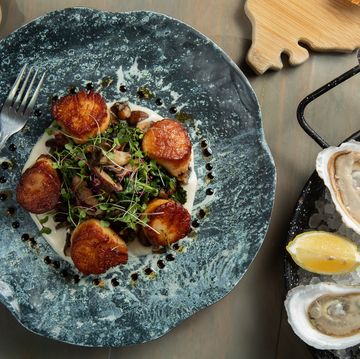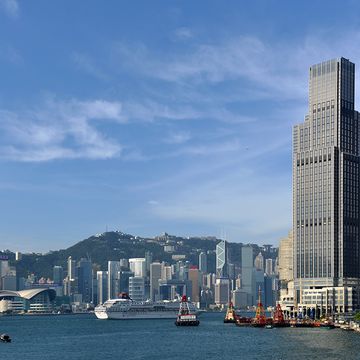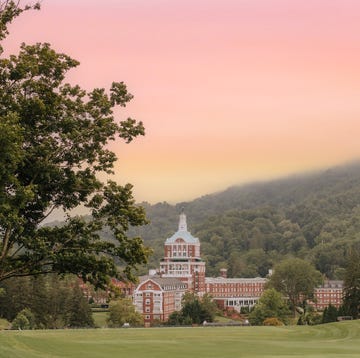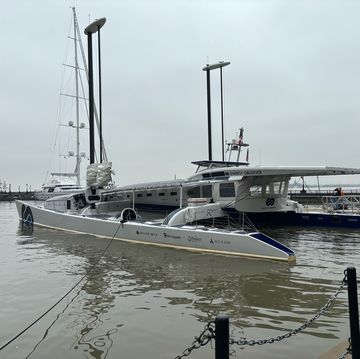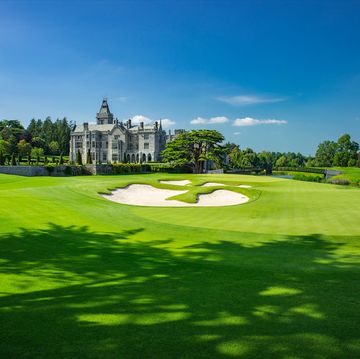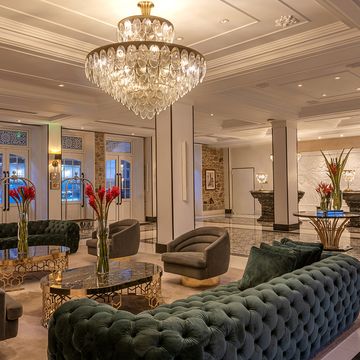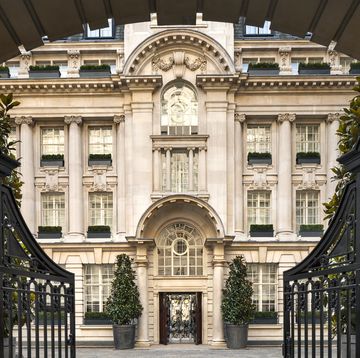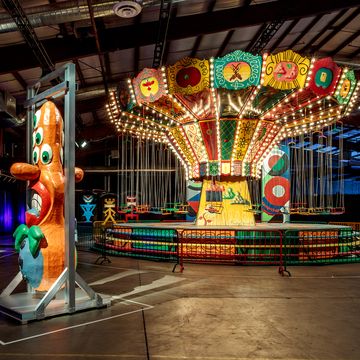It's just after dawn, and we're driving along the rutted highlands highway up through the rain forest, past small villages of thatched-roof houses and groves of banana trees, when our guide sees a male King of Saxony bird of paradise. We stop the van at a bend in the road, a quiet spot at about 7,100 feet here in the Southern Highlands Province of Papua New Guinea.
The bird, a glorious creature with long blue ribbonlike plumes that cascade down his back, sits on the topmost branch of a beech tree. He calls to a dowdy female on a lower branch, shaking his plumage in an attempt to impress her. Unlike the American travelers staring in awe at the stunning bird, the female is not interested and takes off. Her rejected suitor utters a few plaintive cries, then flies in the opposite direction, into the depths of the mist-shrouded, endless green of the New Guinean rain forest.
I'm gazing at birds of paradise on an amateur naturalist's tour of a lifetime organized by Abercrombie & Kent and the Nature Conservancy. Papua New Guinea, little known among Americans, is slightly larger than California; it lies about 100 miles north of Australia and shares the island of New Guinea with Papua, Indonesia's easternmost province. Known as PNG by expats and locals alike, it is considered by scientists the preeminent place to study tropical biodiversity. But beyond whatever priceless creatures scholars find in PNG, this country is just superbly, jaw-droppingly beautiful. Its dramatic landscape encompasses crashing waterfalls and infinite rain forests, snowcapped mountains jutting into the stratosphere, lowland salt swamps crisscrossed by muddy estuaries swarming with crocodiles and, off its northern coast, islands beyond untouched coral reefs that burst with neon-colored aquatic life.
I have spent much of my life in this amazing, unpredictable place. I grew up in pre-independence Papua New Guinea (Australia governed the territory until 1975), in a remote village in the Eastern Highlands, about 400 miles from where I stand bird-watching today. When I was six, my mother, who was working on her doctoral dissertation in social anthropology, moved our family from New York to live simply in PNG's tribal lands. We built a house out of bamboo and thatch, collected rainwater in a fifty-gallon drum, took showers in a canvas-bag contraption my father bought at an Australian Army surplus store and, most nights, ate canned curried goose for supper. Today, transfixed by the King of Saxony soaring into the rain forest, I am as in love with this land and its people at forty as I was as a girl seeing it for the first time.
This ten-day trip is designed to show off Papua New Guinea's most spectacular assets. The Nature Conservancy, which runs four conservation and research projects in PNG, joined with A&K in hopes that these tours would raise North Americans' awareness of the incredible natural treasures on New Guinea. Why this island inspires passion in Western conservationists is obvious: it is home to an astounding 5 percent of the world's species, including 762 types of birds, the most orchid varieties anywhere on Earth and endemic butterflies so unimaginably exquisite, they would make Vladimir Nabokov weep.
Yet visiting PNG can be tricky; it necessitates signing on with an experienced outfitter. The terrain is so rugged and treacherous that more than 860 distinct language groups have evolved on the island in the ten millennia since it was first inhabited. Tribes living for dozens of generations less than 100 miles from one another not only never met but, in many instances, never knew of the others' existence until as recently as the 1950s. No major road system connects the scattered settlements. Much of the rain-forested interior is accessible only by air, and those who want to travel to any far-flung spot in the country must charter a small plane or helicopter. There is also a significant lack of law and order. Although tourists are rarely harmed (and those on guided tours even more rarely), the underequipped police force battles a pervasive urban gang culture, no doubt the result of an up-to-80-percent unemployment rate in the towns. Known as rascals, those who make up these mobs are notorious for brazen acts of theft, vandalism and physical violence.
All of which helps explain how Papua New Guinea, even with its immense natural resources — the nation is rich in gold, oil, copper and timber — has managed to remain a largely untouched Eden. Conservationists worry, however, that these vast untamed stretches are on the brink of destruction. Rural landowners living in deep poverty, many of whom rely solely on rain for their water supply, have begun leasing their properties to international mining, oil and timber companies. If these foreign-owned businesses continue to be granted unchecked access to the forests and coral reefs, the same devastation that has destroyed much of the Asia-Pacific wilderness will no doubt come to this remote land. Abercrombie & Kent may now be leading some of the last visits to an intact natural Papua New Guinea.
The eight other Americans on this trip, all of them widely traveled in the Third World, are among the most sophisticated tourists I have encountered. They are, to a man and woman, the kind of intrepid traveler who usually eschews organized tours and understands without being told how unfamiliar and alien one born and bred in the developed world can feel in a place like Papua New Guinea. We first met at Rondon Ridge, a new eco-lodge outside the town of Mount Hagen, the capital of the Western Highlands Province. The lodge's twelve rooms are immense and extremely comfortable; floor-to-ceiling glass doors open to the wide green Wahgi Valley, an amphitheater of rain forest–covered mountains draped in tendrils of cloud and mist. When I walked into my room, a sweet little wooden pig with a welcome note was waiting on my pillow. My first dinner started with delicious ginger-tinged watercress soup, which was followed by perfectly cooked venison, a salad of native greens and coffee-and-cream pavlova for dessert. Solar-powered electric blankets kept us warm during the cool nights, and piles of fluffy towels awaited us after every shower. But it's here, near the rain forest, in the clear mountain air full of the scent of woodsmoke and vibrating with a symphony of cicadas, birds and owls, that I realize I'm finally back in the magical land that has haunted me since my girlhood. Watching the fat equatorial sun turn pink, scarlet and then bloodred as it sets over the Wahgi Valley, I wonder if I could ever get enough of this place.
The next morning, the nine of us and our guide pile into a rickety van and bounce along a pothole-ridden tarmac to visit a highlands native, Vincent Andambo, at his orchid garden in Avi, near Mount Hagen. Andambo, a quiet man with no formal education (who is followed everywhere by his majestic pet hornbill, Ben-Ben), escorts us around his botanical Aladdin's cave. The garden, which he has named the Avi Cultural Center, is a dream of tropical plants and orchids: the flowers of vanilla orchids brush against my head as I walk past countless varieties of dendrobium crawling along moss-covered tree trunks. Crucifix orchids peek out from between yellow-green leaves, and yellow, orange and blue orchids straight out of Dr. Seuss, all of them insistent in their exotic beauty, curl around tree stumps. The red wild-ginger blossoms and bromeliads planted along the borders of the garden, flowers that usually thrill me, today seem a bit like Cinderella's plain stepsisters.
The most compelling features of Andambo's garden are not flowers at all but the ancestral totems. From the heads of these statues, carved of dried moss to resemble fierce human spirits, real pigs' teeth and tusks erupt and resplendent orchids grow. Traditional highlands culture is full of elaborate rituals, sorcery and a belief in the transcendent powers of the spirit world; since the arrival of Christian missionaries in the 1930s, however, those beliefs have been increasingly supplanted by Western ideas. One of my most vivid childhood memories is of listening to my New Guinean friends' mothers sing growing spells to their sweet-potato plants as they gardened in the rich black soil. Those chants, as well as animist sculptures, like Andambo's, are scarcely seen or heard of anymore.
Nonetheless, snapshots of traditional culture are still visible all over PNG. In both the Southern and Western Highlands, our group watches performance after performance of ancient rites: a troupe of Asaro mud men does its famous dance; we observe a bride and groom in traditional wedding regalia; and in a sacred grove, a medicine man chants spells and burns magic leaves. Our guides arrange for us to see the spirit dances and war rituals of the well-known Huli wig men and take us to meet the headmaster of the wigmaking school, who explains the meticulous work that goes into growing the elaborate headpieces (made partly with the wearer's own hair) the Huli warriors wear into battle. Yet none of the spectacles, which vary from uninspired to extraordinarily moving, contain the urgency of the authentic rituals I witnessed thirty years ago. All the New Guineans I speak with explain that what we tourists are shown is "pagan" — performed only for outsiders and largely disdained by the younger generation as nothing more than a generator of badly needed income.
Papua New Guinea is most thrilling not during these canned cultural presentations but when the nation's people are caught in spontaneous display. One afternoon, as we ride along a Southern Highlands dirt road after a dance performance, we land in the middle of a parade of thousands of locals celebrating the upcoming national elections, the first in five years. It is then that we see a real, unscripted version of Huli culture: men, women and children in traditional dress, faces painted black, red and yellow, hair full of feathers and flowers, dancing and singing in support of the candidates of their choice. For the first time on this trip, I feel the intensity and energy I remember from my youth. These people are passionate and the genuine article: the costumes and songs, the swaggering and chanting, are expressing their deepest desire to elect a leader who will make a tangible difference in their lives. We marvel at the electricity flowing through the crowd, the candidates shouting into bullhorns; it is awesome and momentous to see a young democracy, which has struggled so hard to unite its disparate peoples, in action. Amid the excitement, Ronald, a Washington, D.C., lawyer who has traveled extensively throughout the developing world, turns to me. "This is the most adventurous trip I've ever taken," he says, full of enthusiasm. "There's just so much here!"
Later that evening, in my room at Ambua Lodge, an eco-lodge in a setting even more rustic than Rondon Ridge, I throw open my windows and drink in the vista of the Southern Highlands Province: a constantly changing Impressionist palette of greens, blues, whites, grays and lavenders bleeding into one another. I breathe in the haunting fragrance of the rain forest — a kind of wet-earth and black-pepper scent — and I am flooded with memories of playing in the deep woods as a child. Ambua Lodge is made up of forty circular thatched-roof cottages scattered along a mountain ridge, all with unimpeded views of the rain forest. It's about as remote as you can get in Papua New Guinea's highlands and still have hot running water, flush toilets and electric lights, not to mention gourmet meals served to you three times a day. It's a far cry from my canvas-bag showers in the Eastern Highlands.
After dinner, as our group drinks a bottle of jammy, spicy Australian Shiraz from the lodge's cellar, we're still buzzing about that day's parade, sharing digital snapshots of the revelers' incredible adornments. Adding to our sense of discovery, someone points out that in our five days in the highlands, we have not seen a single tourist besides ourselves.
The next morning, we fly to the north-central coast for the last stretch of our tour. We spend a day traveling via small airplanes, vans and buses to the island of New Britain: specifically, to Kimbe Bay, West New Britain Province, the site of one of the Nature Conservancy's four projects here. We're booked into the Walindi Plantation Resort, a former palm oil and cacao farm that is now the ideal place to unwind after our whirl through the highlands. Enormous rain trees spread vine-covered branches over twelve square, thatched-roof bungalows that sit a few feet off the ground on stilts and look out at the deep blue calm of the sheltered bay. The paths through the resort brim with brilliant, intensely scented purple, pink, orange, blue and yellow tropical flowers. I sit for a half hour on my porch, drinking a South Pacific lager, and watch iridescent bird-wing butterflies float by and listen to hornbills call from the treetops. Yet, nice as it is to be aboveground at Walindi, I can't wait to get underwater: more species of coral and fish live along New Britain island's northern coast than in all of Hawaii and the Caribbean combined. I have yearned to dive in this country ever since I first zipped on a wet suit, ten years ago.
The reefs we visit are covered in coral, an oddity in this age of bleaching and rising ocean temperatures. But before I can get lost in the coral's varieties and shapes, I am engulfed in a cloud of purple anthias fish. In the distance, majestic silver and blacktip sharks (happily, uninterested in scuba divers) swim past a forest of pink sea whips as, nearby, giant angelfish drift along six-foot-tall sea fans that weave back and forth in the current.
When I was a child, the rain forests of Papua New Guinea opened a whole world to me — light, color, smell, birds, flowers, trees — all in a kind of perfect harmony. In those woods I first became aware of myself as one living thing connected to many others. And I feel that way again, floating underwater in the midst of the exuberant life on this New Britain reef. The hawksbill sea turtles, the luridly colored parrot fish and the translucent, trembling fingers of sea anemones hold out to me the promise of transcendence that Papua New Guinea always offers whenever I reach for it.
How to Get There
The next Abercrombie & Kent–Nature Conservancy trip to Papua New Guinea is scheduled for June 8 through June 19 (from $5,866 a person, all-inclusive except for international airfare; 888-785-5379; abercrombiekent.com/tnc).Flying on Qantas (800-227-4500; qantas.com.au) is the easiest way to get from the United States to PNG; the airline will also book your intra-country travel on Air Niugini. A sixty-day tourist visa can be obtained beforehand from the Papua New Guinean embassy (pngembassy.org) in Washington, D.C.


